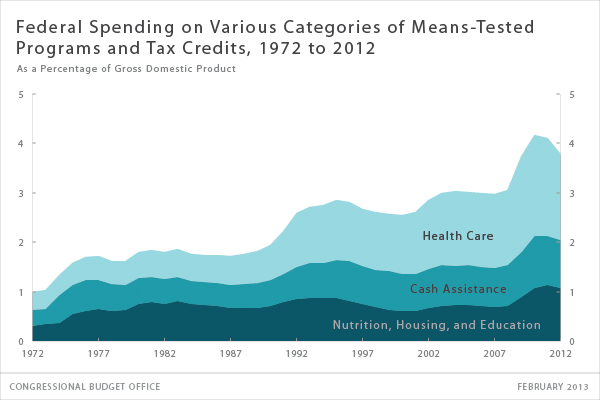CBO just released a report on means-tested programs: See full report:Click Here  “The federal government devotes roughly one-sixth of its spending to 10 major means-tested programs and tax credits, which provide cash payments or assistance in obtaining health care, food, housing, or education to people with relatively low income or few assets. Those programs and credits consist of the following: Medicaid, canadian pharmacy la roche posay The low-income subsidy (LIS) for Part D of Medicare (the part of Medicare that provides prescription drug benefits), The refundable portion of the earned income tax credit (EITC), The refundable cheap viagra online portion of the child tax credit (CTC), Supplemental Security Income (SSI), Temporary Assistance for Needy Families (TANF), The Supplemental Nutrition Assistance Program (SNAP, formerly called the Food Stamp program), Child nutrition programs, Housing assistance programs, and The Federal Pell Grant Program. As shown in this report and an accompanying infographic, in 2012, federal pharmacycanada-rxedtop.com spending on those programs and tax credits totaled $588 billion. (Certain larger federal benefit programs, such as Social Security and Medicare, are not considered means-tested programs because they are not limited to buy viagra online people with specific amounts of income or assets.) Total federal spending on those 10 programs (adjusted to exclude the effects of inflation) rose more than tenfold—or by beta blockers and cialis an average of about 6 percent a year—in the four decades since 1972 (when only half of the programs existed). As a share http://cialisgeneric-toped.com/ of the economy, federal spending on those programs grew from 1 percent to almost 4 percent of gross domestic product (GDP) over that period. (For ease of presentation, this report frequently uses the term “programs” to encompass both the spending programs and the tax credits.)” Check out chart:Click Here
“The federal government devotes roughly one-sixth of its spending to 10 major means-tested programs and tax credits, which provide cash payments or assistance in obtaining health care, food, housing, or education to people with relatively low income or few assets. Those programs and credits consist of the following: Medicaid, canadian pharmacy la roche posay The low-income subsidy (LIS) for Part D of Medicare (the part of Medicare that provides prescription drug benefits), The refundable portion of the earned income tax credit (EITC), The refundable cheap viagra online portion of the child tax credit (CTC), Supplemental Security Income (SSI), Temporary Assistance for Needy Families (TANF), The Supplemental Nutrition Assistance Program (SNAP, formerly called the Food Stamp program), Child nutrition programs, Housing assistance programs, and The Federal Pell Grant Program. As shown in this report and an accompanying infographic, in 2012, federal pharmacycanada-rxedtop.com spending on those programs and tax credits totaled $588 billion. (Certain larger federal benefit programs, such as Social Security and Medicare, are not considered means-tested programs because they are not limited to buy viagra online people with specific amounts of income or assets.) Total federal spending on those 10 programs (adjusted to exclude the effects of inflation) rose more than tenfold—or by beta blockers and cialis an average of about 6 percent a year—in the four decades since 1972 (when only half of the programs existed). As a share http://cialisgeneric-toped.com/ of the economy, federal spending on those programs grew from 1 percent to almost 4 percent of gross domestic product (GDP) over that period. (For ease of presentation, this report frequently uses the term “programs” to encompass both the spending programs and the tax credits.)” Check out chart:Click Here